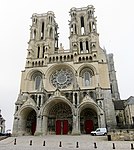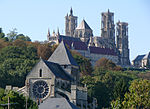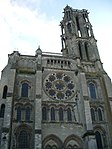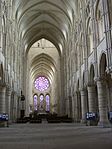Notre-Dame i Laon
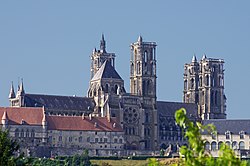
Cathédrale Notre-Dame de Laon, Notre-Damekatedralen i Laon, är en byggnad i gotisk stil i staden Laon i Aisne i norra Frankrike uppförd under tiden 1150–1250.
Katedralen påminner starkt om Notre-Dame i Paris. Mittskeppsarkaden är, liksom i Paris, försedd med rundpelare med klassiska akantuskapitäl och en väl genomlyst emporvåning under triforiet. Laon-katedralens nordfasad byggdes med plats för två stora torn, varav endast ett konstruerades.
Berömt är katedralens stora kor som bär alla unggotikens kännemärken. En egenhet är det romanska tornet över korsmitten.
Biildgalleri
- Västfasaden på Notre-Dame i Laon
- Vy över katedralen, från nordöst
- De båda västtornen, sedda österifrån över taket
- Katedralens norra tvärskeppsfasad, med torn (finns ett torn även vid södra tvärskeppet)
- Sydtornet vid södra tvärskeppet, sett från sydvästtornet
- Mittskeppet i katedralen
- Vattenkastare i form av en noshörning
Externa länkar
 Wikimedia Commons har media som rör Notre-Dame i Laon.
Wikimedia Commons har media som rör Notre-Dame i Laon.
Media som används på denna webbplats
Laon's cathedral, Aisne, France
Författare/Upphovsman: Daniel Jolivet, Licens: CC BY 2.0
Cathédrale Notre-Dame de Laon.
Edifice gothique majeur de France. Sa construction est antérieure à la cathédrale Notre-Dame de Paris.
La cathédrale actuelle remplace un édifice endommagé lors de la révolte communale de 1112. Elle fut édifiée à partir 1115, en moins de cinquante ans.
La révolte communale de Laon s'inscrit dans une période de bouleversements sociaux (Le Mans 1070, Noyon 1108).
La ville de Laon est soumise à un double pouvoir : royal et épiscopal. Le roi et l'évêque ont chacun leurs partisans.
En 1098, l'évêque, Enguerrand de Coucy, sépare le pouvoir épiscopal du pouvoir royal.
En 1106, son successeur élu, l'évêque Gaudry renforce le climat de tension dans la ville. Sous prétexte d'une querelle, l'évêque fait assassiner le châtelain royal Gérard de Quierzy, en prière dans la cathédrale, en 1111. Pour ne pas être soupçonné, Gaudry partit pour Rome quelques jours avant.
La population accusant ouvertement l'évêque, le roi Louis VI persuadé de la culpabilité de Gaudry, dépouille le palais épiscopal de tous ses biens.
Toujours à cours d'argent, Gaudry essaye pas tous moyens de lever des taxes supplémentaires. Gaudry tente également d'arrêter la constitution de la ville en commune promise par le roi aux bourgeois. La colère de la population grandit. Le roi juge prudent de quitter la ville. Le 25 avril 1112, c'est l'insurrection.
L'abbé Guibert, de Nogent-sous-Coucy relate dans la "Révolte du peuple de Laon contre son évêque", la fin de l'évêque Gaudry:
"Et voici que la populace insolente, qui hurlait devant les murailles du palais, attaque enfin l'évêque. Celui-ci, aidé de quelques-uns de ceux qui s'étaient portés à son secours, tint l'ennemi en respect tant qu'il put en jetant des pierres, en tirant des flèches.(…). Incapable de contenir les assauts audacieux du peuple, il prit les vêtements d'un de ses esclaves, se réfugia dans le cellier diocésain et s'y cacha dans un petit fût où il se fit enfermer (…) Où donc est ce pendard?" criaient les gens parlant de l'évêque(…). Les voici qui portent la main sur un de ses petits valets, (…), ils ne lui peuvent soutirer rien de satisfaisant. Ils en saisissent un autre, et ce perfide, d'un signe de tête, leur fait comprendre de quel côté il faut chercher. Ils pénètrent alors dans le cellier, fouillent de toute part et finissent par découvrir l'évêque de la manière que je vais dire. Theudegaud était un grand scélérat; serf de l'église Saint-Vincent, il avait été longtemps ministérial et prévôt au service d'Enguerran de Coucy, et percevait des droits de péage au pont de Sort. Il lui arrivait alors de guetter le moment où il y avait peu de voyageurs, il dépouillait ceux-ci de tout, mais ensuite, pour éviter des actions qu'ils eussent intentées contre lui, il les jetait, une pierre au cou, dans la rivière. (…). Lorsqu'il fut tombé en disgrâce auprès d'Enguerran, il épousa entièrement la cause de la commune de Laon. Cet homme, qui n'avait naguère épargné ni moine, ni clerc, ni pèlerin, ni homme ni femme, se proposa finalement de tuer l'évêque. (…) Ainsi donc, tandis que les émeutiers cherchaient notre homme dans les tonneaux, l'un après l'autre, Theudegaud s'arrêta devant celui-là même où Gaudry se cachait, en fit sauter le fond(…) Alors celui qui, tout pécheur qu'il fût, n'en était pas moins l'oint du Seigneur, est arraché du tonneau, tiré par les cheveux, roué de coups, puis entraîné en plein air, dans une ruelle du quartier des clercs, devant la maison du chapelain Godefroy. Là, il se mit à les implorer lamentablement, à leur garantir par serment que jamais plus il ne serait leur évêque, leur promettant d'énormes sommes d'argent et assurant qu'il quitterait le pays(…). Finalement, un nommé Bernard, dit de Bruyères, brandit une hache double, frappa à la tête cette homme sacré, encore que pécheur, et en fit brutalement jaillir la cervelle. (…) Aussitôt on brise les jambes de ce cadavre, et on lui porte encore bien d'autres coups. Cependant, Theudegaud, apercevant l'anneau au doigt du feu pontife, et ne réussissant pas à l'arracher facilement, tranche le doigt du défunt d'un coup d'épée et s'empare de l'anneau. Dépouillé de ses vêtements, le corps est enfin jeté, entièrement nu, dans un coin, devant la demeure de son chapelain. Dieu! qui pourrait retracer de combien d'affreuses railleries les passants accablèrent ce corps, de combien de boue, de pierres et de gravats ils le criblèrent?"
Notre-Dame de Laon.
Major Gothic building in France. Its construction is prior to the Notre Dame Cathedral in Paris.
The present cathedral replaces a building damaged during the communal uprising of 1112. It was built from 1115 in less than fifty years.
The Revolt of communal Laon is in a period of social upheaval (Le Mans 1070, Noyon 1108).
The town of Laon is subject to a dual power: royal and episcopal. The king and bishop each have their supporters.
In 1098, the bishop, Enguerrand de Coucy, separates the episcopal power of royal power.
In 1106, his chosen successor, Bishop Gaudry reinforces the climate of tension in the city. Under the pretext of a quarrel, Bishop murdered royal squire Gerard Quierzy in prayer in the cathedral in 1111. Not to be suspected, Gaudry left for Rome a few days before.
The population openly accusing the bishop, Louis VI convinced of the guilt of Gaudry, remains the episcopal palace of all his possessions.
Always running out of money, Gaudry not try all means to raise additional taxes. Gaudry is also trying to stop the building of the city municipality promised by the king to the bourgeois. The anger of the population grows. King considers it prudent to leave the city. April 25, 1112, is insurrection.
Abbot Guibert of Nogent-sous-Coucy recounts in "Revolt of the people of Laon against his bishop," the late Bishop Gaudry:
"And now the insolent populace, screaming at the walls of the palace, and finally attack the bishop. Latter, aided by some of those who had come to its rescue, kept the enemy at bay so that it could by throwing rocks, shooting arrows. (...). Unable to contain the bold attacks of the people, he took the clothes of one of his slaves, took refuge in the cellar diocesan and hid in a small wood where he shut him up (...) Where is that scoundrel? " cried the people speaking of the bishop (...). Here they are hands on one of his little servants, (...), they can squeeze him nothing satisfactory. They grab another, and treacherous, a nod, makes them understand which way to search. They then enter the cellar and searched on all sides and eventually discover the bishop of the way I say. Theudegaud was a great villain, serf of the Church of St. Vincent, it was long and provost at the Ministerial Enguerran service Coucy and perceived rights Bridge toll Spell. He happened to watch when there were few travelers, he stripped them of everything, but then, to avoid actions they had taken against him, he threw a stone at the neck in the River. (...). When he fell out of favor with Enguerran he married fully the cause of the municipality of Laon. This man, who had once spared neither monk or cleric, or pilgrim, man or woman, finally proposed to kill the bishop. (...) Thus, while rioters tried our man in the barrels, one after another, Theudegaud stopped before it even where Gaudry was hiding in blew the bottom (...) So who, every sinner he was, was nevertheless the Lord's anointed, the barrel is pulled, pulled by the hair, beaten and driven outside in an alley in the neighborhood clerics, to the house of the chaplain Godefroy. There he began to implore miserably to guarantee them by oath he never again would be their bishop, promising them huge sums of money and ensuring that he would leave the country (...). Finally, a man named Bernard says Bruyeres, holds a double ax, knocked on the head this holy man, yet a sinner, and was brutally spring brains.
(...) As soon as you break the legs of the corpse, and brought him many more shots. However, Theudegaud, seeing the ring finger to the late pontiff, and failing to pull it off easily slice a finger of the deceased to his sword and took the ring. Stripped of his clothes, the body is then thrown naked in a corner, in front of the home of his chaplain. God! who could trace how hideous taunting passers overwhelmed the body, how much mud, stones and rubble they riddled him? "Vue de la cathédrale Notre-Dame de Laon.
Författare/Upphovsman: Acroterion, Licens: CC BY-SA 4.0
West towers and roof of Laon Cathedral from central tower
Författare/Upphovsman: Vegetarien75, Licens: CC BY-SA 3.0
le rhinocéros de la façade
Författare/Upphovsman: Acroterion, Licens: CC BY-SA 4.0
South tower from southwest tower, Laon Cathedral
Författare/Upphovsman: Paul Hermans, Licens: CC BY-SA 3.0
Inside view of the cathedral in Laon - own work by nl:Gebruiker Paul Hermans
Författare/Upphovsman: Velvet, Licens: CC BY-SA 3.0
La façade de la cathédrale Notre-Dame de Laon (Aisne).
